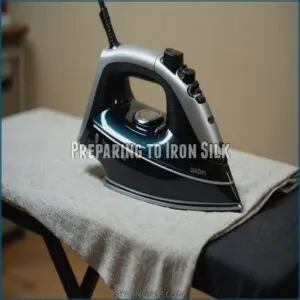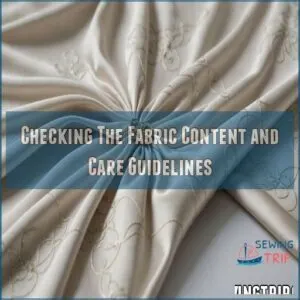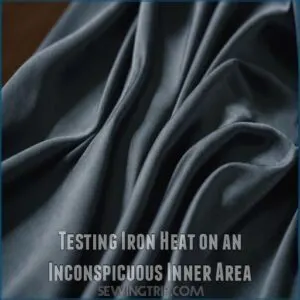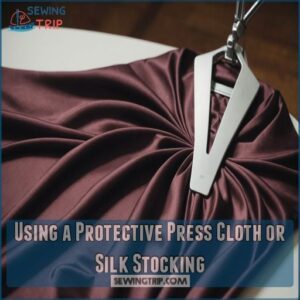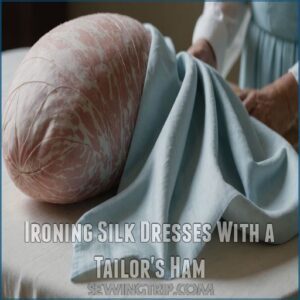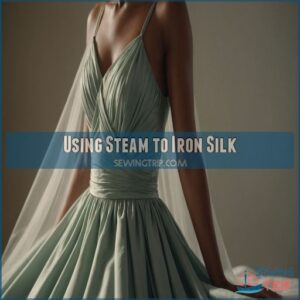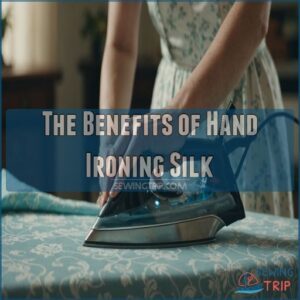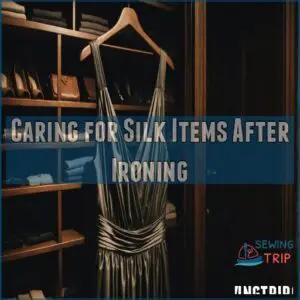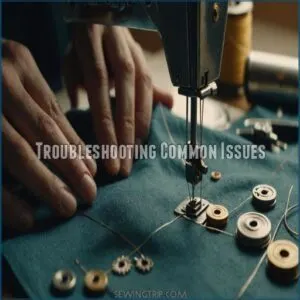This site is supported by our readers. We may earn a commission, at no cost to you, if you purchase through links.
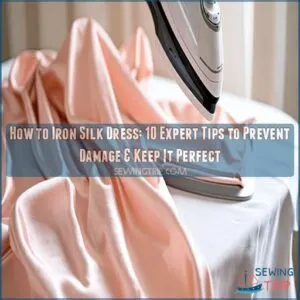 Ironing a silk dress is like handling a cat—delicate and precise.
Ironing a silk dress is like handling a cat—delicate and precise.
Start by slightly dampening the dress and setting your iron to the lowest heat.
Lay it on a clean, flat surface.
Slip a thin cloth between the silk and iron, then carefully press without pushing back and forth.
Keep the iron hovering between strokes to avoid overheating.
It’s all about patience, like waiting for toast without burning it.
Using a press cloth prevents shine marks.
Each swipe should maintain the fabric’s luster.
For those who crave perfection, there are more tricks up the sleeve that keep your silk flawless.
Table Of Contents
- Key Takeaways
- Preparing to Iron Silk
- Choosing The Right Ironing Surface
- Ironing Silk: a Step-by-Step Guide
- Tips for Ironing Silk Dresses
- Avoiding Common Mistakes
- Using Steam to Iron Silk
- The Benefits of Hand Ironing Silk
- Caring for Silk Items After Ironing
- Troubleshooting Common Issues
- Professional Ironing Services for Silk
- Frequently Asked Questions (FAQs)
- Conclusion
Key Takeaways
- To iron silk effectively, it’s essential to understand that silk’s natural propensity for wrinkles makes it prone to creasing, so set your iron to a low temperature and use a protective cloth to protect the delicate silk fabric while ironing.
- Work in sections from top to bottom, using light pressure without sliding the iron to maintain the silk’s sheen and shape.
- Test the iron’s heat on an inconspicuous inner area to prevent any risk of scorching or shine marks.
- Use steam carefully as an alternative to relax fibers and remove wrinkles without direct heat contact.
Preparing to Iron Silk
You’ll need to gather your supplies and set up properly before taking an iron to your precious silk dress.
Before you start, make sure you’ve got a clean iron, pressing cloth, and ironing board ready.
Check that your iron’s temperature is set to the silk-friendly range of 150-270°F.
Gathering Necessary Supplies
Getting ready to iron silk doesn’t have to be a headache.
Before you start, gather these essential items to make sure your silk dress stays pristine:
- A clean, reliable iron with adjustable temperature settings
- A high-quality pressing cloth or silk organza to protect delicate fabric
- A sturdy ironing board with a smooth, clean cover
- A spray bottle filled with distilled water for light misting
Keep these supplies within arm’s reach to make the process smooth and efficient.
Setting The Iron to a Low-to-cool Heat Setting
Now that you’ve got your supplies ready, let’s talk temperature.
Think of silk like a delicate flower – too much heat will wilt it.
You’ll want to keep your iron’s temperature at 270°F or below.
Here’s a quick guide to help you nail the perfect setting:
| Silk Type | Temperature | Steam Setting | Time Per Section |
|---|---|---|---|
| Light Silk | 150-200°F | Low | 2-3 seconds |
| Medium Silk | 200-230°F | Medium | 3-4 seconds |
| Heavy Silk | 230-270°F | Medium | 4-5 seconds |
| Embroidered | Under 200°F | None | 2-3 seconds |
Using an Iron With Precise Temperature Control
Your iron’s temperature control panel is your best friend when working with silk.
Look for models featuring precise digital displays or clear silk settings – they’re worth every penny.
Keep the temperature steady between 250-270°F, and always test the heat on a hidden spot first.
If your iron lacks exact controls, stick to the lowest heat setting and work your way up gradually.
Identifying The Type of Silk Fabric
Before heating up that iron, take a moment to identify your silk fabric type.
Understanding what you’re working with makes all the difference.
Look out for these key indicators:
- Check the care label for fabric content and specific blend percentages
- Feel the weight and texture – lightweight silks need gentler handling
- Notice the luster and sheen – high-shine silks are more prone to showing iron marks
Choosing The Right Ironing Surface
You’ll want to iron your silk dress on a completely smooth, clean surface that’s padded with a soft pressing cloth or cotton sheet to prevent snags and shine marks.
While your ironing board works well, you can also create a makeshift pressing station on a flat table by laying down a thick cotton towel or blanket as your base.
Using a Clean Pressing Surface
After gathering your supplies, finding the right surface makes all the difference.
A clean, flat ironing board provides the ideal foundation for pressing silk.
Make sure the surface is free from debris, stains, or residue that could transfer onto your dress.
If you don’t have an ironing board, a sturdy table works too – just make sure it’s spotless and completely stable.
Covering The Surface With a Sheet, Mat, Towel, or Blanket
A protective layer between your ironing board and silk dress acts like a cushioning shield.
Start by laying down a clean white cotton sheet as your base layer, then consider adding a smooth pressing cloth or mat for extra protection.
If you’re in a pinch, a plush white bath towel or lightweight blanket works well too – just make sure it’s perfectly clean and lint-free.
Selecting a Surface for Silk Items With Embroidery
The delicate embroidery on silk items requires extra cushioning to prevent flattening or damage.
Set up a plush ironing surface by layering two soft towels or using specialized ironing board padding.
This raised, soft foundation allows embroidered details to sink in while you work.
For intricate pieces, consider placing a clean white cotton pillowcase on top – it’ll protect both the embroidery and the silk’s finish.
Ironing Silk: a Step-by-Step Guide
You’ll master the art of ironing silk with our simple, proven method that prevents damage and keeps your dress looking flawless.
With the right temperature setting and gentle technique, you can transform your wrinkled silk dress into a perfectly pressed masterpiece that’s ready to wear.
Checking The Fabric Content and Care Guidelines
Always check your silk dress’s care label before reaching for that iron.
You’ll find essential details about fabric composition and recommended temperatures.
Pay special attention to care symbols – they’re like a secret code telling you exactly what your dress needs.
If the label’s missing or worn out, assume it’s 100% silk and proceed with extra caution to protect your precious garment.
Testing Iron Heat on an Inconspicuous Inner Area
Before tackling your silk dress, take a minute to test the iron’s heat on a hidden spot like an inner seam, remembering that genuine silk fabric glides smoothly between the fingertips and has a distinctive natural scent when warm, unlike synthetics learn more about silk’s properties.
Smart testing helps prevent those heart-stopping moments when you discover a scorch mark.
Here’s your foolproof testing strategy:
- Pick an inside hem or seam
- Press for 3-5 seconds
- Check for any shine or discoloration
- Wait 30 seconds before adjusting temperature
Using a Protective Press Cloth or Silk Stocking
To prevent heat damage and keep silk flawless, consider its natural temperature regulation properties, which allow silk to trap warm air. To keep silk flawless and free from heat damage, slip a protective press cloth or even a trusty silk stocking between your iron and delicate fabric.
This barrier makes sure that you maintain heat control and prevent unfortunate marks.
Explore creative press cloth alternatives—each offering a unique touch of care, making sure the silk’s luxurious sheen remains untarnished.
Working in Sections From Top to Bottom
Ironing silk isn’t a task you rush through.
Divide your dress into manageable sections, working your way from top to bottom.
This focused ironing direction helps maintain silk’s shape and sheen.
- Pressure control: Use light touch.
- Section size: Small for precision.
- Lifting technique: Gentle, don’t drag.
- Steam application: Light mist, if needed.
- Avoid haste: Patience pays off.
Tips for Ironing Silk Dresses
When ironing silk dresses, you’ll want to use a tailor’s ham to preserve the dress’s natural shape.
Carefully iron each layer separately to avoid creases.
Make sure the entire dress looks flawless.
Ironing Silk Dresses With a Tailor’s Ham
Getting that silk dress just right? Reach for a tailor’s ham. It gives you the perfect curve for seams and darts, keeping those stubborn wrinkles at bay.
With fabric types in mind, this handy tool offers a chance to steam or dry areas without flattening them out.
You’ll see, a real ham’s your go-to for that professional finish.
Maintaining The Shape of The Dress
When ironing silk dresses, don’t let details like bust darts and pleats lose their shape.
To iron pleats that are stubborn or have lost their crispness, consider using a technique similar to ironing pleated skirts, such as spritzing the pleat with natural starch for pleats.
Follow these quick tips:
- Hemline: Gently steam the fabric, smoothing it by hand.
- Sleeves: Use a sleeve board to maintain structure without flattening.
- Dress Shape: Lift and press lightly, working toward seams to keep the silhouette intact.
Ironing Layers Separately
Sometimes, tackling a multi-layered silk dress feels like untangling a mystery.
To get it right, be sure to separate each layer—this helps avoid wrinkles and scorching.
Use the table below for guidance:
| Step | Action | Outcome |
|---|---|---|
| 1 | Identify layers | Clear organization |
| 2 | Use a press cloth | Protects fabric |
| 3 | Iron gently | Prevents damage |
| 4 | Allow cooling | Maintains shape |
Approach each layer as its own masterpiece, and you’ll keep that dress flawless.
Avoiding Common Mistakes
Let’s face it, ironing silk can be tricky! This section will help you avoid common mistakes like scorching or creating shiny patches, ensuring your silk dress stays looking its best.
Ironing Silk at Too High Heat
You’re ironing silk dresses, aiming for elegance over disaster.
But watch out—high heat’s a silk assassin! It can sneakily turn fabric:
- Into shiny patches
- Melted fiber mess
- Scorched off-white nightmares
- Wrinkled, irreversible chaos
- Shrunk silk spectacles
Adjust your iron’s temperature for a safe styling journey, and keep that silky charm intact! Iron smart, not hard!
Removing Minor Iron Marks
Iron marks can feel like a stain on your silk masterpiece.
Use a damp cloth, apply medium iron heat, and gently press—don’t glide.
If you’re prone to iron marks, consider using products for silk iron marks removal.
If the mark persists, mist a little vinegar solution on the spot.
Make sure your fabric type is compatible.
This process gives new life to your garment without any fuss!
Here’s a quick guide:
| Step | Detail |
|---|---|
| 1 | Place damp cloth |
| 2 | Set medium iron heat |
| 3 | Press gently, don’t glide |
| 4 | Use vinegar solution |
| 5 | Check fabric type |
Preventing Scorch Marks and Shiny Patches
Rushing through ironing can lead to scorch marks and shiny patches.
To dodge these pesky issues, especially when working with delicate fabrics like silk, you should follow general fabric care tips, such as using cold water, to prevent damage.
Follow these steps:
- Use a press cloth: Protect silk by placing a cloth between the iron and fabric.
- Keep the iron temp low: Set it to “silk” on your iron.
- Steam use with caution: Apply light steam to prevent direct heat damage.
Better safe than sorry, right?
Using Steam to Iron Silk
For ironing silk, steam can be your best ally in removing wrinkles and relaxing fibers without direct heat.
Just be careful not to overdo it—too much steam can make silk lose its shape or become water-stained.
Steaming Silk to Relax Fibers
Wrangling silk’s delicate nature? Look, skipping high heat’s a smart move.
When you steam to relax silk fibers, it’s like giving them a little yoga session.
Use steam settings gently, trusting the mist to soothe.
To avoid water spots on delicate fabrics, follow a satin steamer guide how to steam a satin dress.
Understanding fiber types helps you treat silk with care.
Remember, less is more. With these silk care tips, you’ll master the art of finesse.
Steaming Silk to Remove Wrinkles
After relaxing silk fibers, tackle wrinkles with smart steaming techniques.
Grab a steamer—your magic wand—to smoothly glide over fabric, and if you need a new one, you can find great options at a Silk steamer website.
Keep the steamer at a safe distance, letting gentle steam waves work their magic.
No steamer? A hot shower works wonders. Hang the dress nearby and let the steam do its dance, releasing those pesky wrinkles.
Using Steam With Caution on Silk Items
Removing wrinkles with steam is great, but remember, silk’s a delicate flower.
Too much steam, even on low settings, can lead to steam burns or damage certain silk fabric types.
Always test a hidden area first.
If you’re unsure, hand steaming or exploring steam alternatives like a cool iron and damp cloth is a safer bet.
Better safe than sorry!
The Benefits of Hand Ironing Silk
Hand ironing silk helps you preserve its delicate texture and maintain its luxurious appearance.
By carefully controlling the iron’s temperature and pressure, you can guarantee that even the most intricate silk items stay in perfect condition.
Maintaining The Quality of Silk Items
Keeping silk in top shape means treating it like the royalty it is.
A gentle wash or professional dry cleaning helps prevent those pesky stains.
And when it comes to ironing, avoid heavy-handed fabric softeners which can dull its sheen.
For storage, consider padded hangers or folding with acid-free tissue, ensuring silk stays regal and ready for its next outing.
Preserving The Texture and Appearance of Silk
When you’re keeping your silk looking its best, consider gentle care like a whisper in a library.
For those occasional wrinkles, a silk iron can be a lifesaver, and you can find the right one at Silk Iron products.
Silk’s delicate texture loves soft handling, so stick to silk care tips like hand washing and using gentle detergents.
Store it properly, hanging or folding with acid-free paper.
And if stains sneak in, dry cleaning silk can save the day!
Hand Ironing for Delicate or Intricate Items
Silk garments are like old friends—handle with care.
To minimize waste and prevent damage, cut one layer at a time when working with delicate silk fabrics using silk cutting techniques. Use hand ironing techniques to preserve delicate silk fabric types.
Gently press with a cool iron, using a press cloth to protect embroidered details.
Avoid direct heat; steam lightly instead.
This approach prevents damage, giving you mastery over your wardrobe’s most intricate items.
Enjoy the freedom that comes with perfect care.
Caring for Silk Items After Ironing
After ironing your silk dress, proper storage can keep it looking fresh and flawless.
Store it in a cool, dark place.
Fold it with acid-free tissue paper.
Or hang it on padded hangers to prevent wrinkles and damage.
Storing Silk Items in a Cool, Dark Place
Stashing your silk treasures in a cool, dark place is like sending them on a luxurious vacation away from harmful elements.
This simple storage trick prevents light damage and keeps pesky moths at bay.
For best storage, consider using climate-controlled fabric storage methods to maintain the quality of your silk items.
Avoid humid spots, as moisture can lead to unwanted surprises like mold or wrinkles.
Your silk deserves a resting space as elegant as itself!
Folding Silk Items With Acid-free Tissue Paper
After storing your precious silks in a cool, dark place, let’s talk about folding.
Proper folding is key to keeping those gorgeous garments in tip-top shape.
Here’s how you do it like a pro:
- Use acid-free tissue paper—it prevents yellowing!
- Fold gently, avoiding creases.
- Layer tissue between folds.
- Choose soft, acid-free tissue.
- Store flat in a drawer.
This keeps your silks looking fabulous for years to come!
Hanging Silk Items on Padded Hangers
Picture your silk elegance on padded hangers—it’s like granting them a plush throne.
These hangers help with shape retention and wrinkle prevention, essential for delicate fabrics.
Think of it as giving them the royal treatment they deserve.
To make sure your garments stay fabulous, always choose padded options, keeping them away from pointy hangers that could mar their perfection.
Troubleshooting Common Issues
When ironing silk dresses, it’s easy to encounter pesky problems like scorch marks or shiny patches.
Don’t worry—there are simple tricks to fix these issues and keep your dress looking flawless.
Removing Scorch Marks
You’ve accidentally scorched your silk dress.
No worries—it happens to the best of us.
For minor scorch marks, try a home remedy by dabbing the spot with a vinegar-water mix; always test first.
If stains persist, consider seeking professional help for these tricky fabric types.
Preventative measures like using a press cloth can save future headaches.
Fixing Shiny Patches
Tackling shiny patches on silk? They’ve got a mind of their own! Here’s a surefire rescue plan:
- Dab the shiny spot with a white cloth dipped in mild vinegar.
- Gently steam the area from a safe distance.
- Use a press cloth between the iron and fabric.
- Keep ironing temperature low to avoid future surprises.
Preventing shiny patches is key!
Dealing With Burnt or Damaged Silk
If your silk ends up with burns or damage, don’t lose hope.
Often, you can outsmart the damage with some simple restoration tricks.
Try dyeing small scorches to match the fabric.
If repair seems impossible, consider these alternatives:
| Method | Pros | Cons |
|---|---|---|
| Dyeing | Color Match | Time-Consuming |
| Patching | Quick Fix | May Show |
| **Professional | Expert Repair** | Can Be Expensive |
| Hand Sewing | Personalized Touch | Skill Required |
| Covering | Immediate Results | Not Always Durable |
Professional Ironing Services for Silk
If you’re worried about ironing your silk dress at home, consider using professional ironing services to make sure it stays perfect.
These services specialize in handling delicate fabrics, giving you peace of mind and saving you time.
Identifying Professional Ironing Services
Finding a pro to iron your silk dress? Start by checking their reputation.
Look for online reviews and see what past clients say.
Price is a factor, but don’t let it overshadow expertise.
Consider their location—convenience matters!
A quick web search can uncover local options with stellar reviews.
You’ll feel confident knowing your precious silk is in capable hands.
Choosing The Right Service for Your Silk Items
Choosing the right service for your silk items is like selecting a trusted babysitter.
You need confidence!
Look for professional cleaners with glowing service reviews.
Explore dry cleaning options and chat with local tailors about their expertise.
Don’t miss out on a price comparison to make sure you’re not paying a pretty penny for perfection.
Benefits of Professional Ironing for Delicate Items
Hand over your silk dress to professionals and watch it thrive. Here’s why you’ll love it:
- Professional expertise gives your delicate items the best treatment.
- Time-saving solutions let you enjoy more free time.
- Specialized tools guarantee precision and protection.
- Expert care extends the lifespan of your garments.
It’s like giving your silk a luxury vacation!
Frequently Asked Questions (FAQs)
How do you iron a silk dress?
Start by setting your iron to a low-temperature silk setting.
Use a press cloth or sheet to protect the fabric.
Iron sections gently, from top to bottom, lifting and lowering the iron with light pressure.
How do you iron a silk shirt?
To iron a silk shirt, set your iron to low heat.
Use a press cloth to protect the fabric.
Gently press, not slide, the iron over the sections.
Test heat on an inconspicuous area first.
Can You iron a silk dress with a hot iron?
Silk’s a sensitive sweetheart; a scorching iron spells disaster. Use a low setting, a press cloth, and gentle motions. Success awaits your careful touch!
How to Iron Silk?
Iron silk by setting your iron to a low heat.
Cover the fabric with a press cloth, then gently press, not glide, the iron.
Test a small area first to avoid damaging this delicate fabric.
How do you get wrinkles out of a silk dress?
Start by hanging your silk dress in a steamy bathroom; the steam will help relax wrinkles.
Ironing
If needed, use an iron on the lowest setting with a press cloth to gently press out stubborn wrinkles.
Is it better to steam or iron silk?
Imagine your silk dress floating gracefully under the weight of steam—it’s often better than ironing.
Steaming gently relaxes wrinkles without direct contact, preserving silk’s delicate nature and luster.
Try steaming first for effortless elegance.
Can you iron over silk?
You can iron over silk, but take care!
Use a low heat setting and a press cloth to protect the fabric.
Test on a hidden spot first to avoid any shiny patches or scorch marks.
What temperature to iron silk?
When ironing silk, keep the heat low—around 150°F to 270°F.
Think of silk as a delicate flower; too much heat, and it wilts.
Use a light hand and an iron with precise control.
Can I iron silk dresses with embroidery?
Ironing silk dresses with embroidery requires extra care.
Use a low temperature (under 200°F), and cover the embroidery with a press cloth.
This prevents direct contact with the iron, avoiding any unwelcome surprises like damage or shine.
What alternative methods remove wrinkles from silk?
Steam your silk garment in the bathroom after a hot shower, or hang it overnight.
A gentle hand wash and careful air drying also work wonders.
Try a fabric steamer for a quick fix!
How often should silk dresses be ironed?
Iron silk dresses sparingly—it’s like managing a relationship with a skittish cat.
Let your dress rest largely wrinkle-free, only smoothing it out when absolutely necessary, using a low setting to keep its sleek, silky finish intact.
Is it safe to use starch on silk dresses?
Using starch on silk isn’t recommended.
Silk’s delicate fibers can weaken or stain with starch application.
To keep your silk dress looking crisp, try steaming it gently or use a pressing cloth to protect it.
Can I iron silk without a press cloth?
Ironing silk without a press cloth is like juggling fire—risky!
Heat can damage this delicate fabric.
Use a cloth or iron the garment inside out.
Otherwise, you might end up with a shiny, mishaped outfit.
Conclusion
Mastering how to iron a silk dress is like conducting a symphony; precision and care result in perfect harmony.
By preparing properly, selecting the right tools, and following a methodical approach, you’ll keep your silk garments flawless.
Remember to use low heat, protect the fabric with a press cloth, and handle each section gently.
Avoiding common pitfalls will help your silk dress remain stunning.
With practice, your skill will become second nature, preserving the elegance of your wardrobe.

